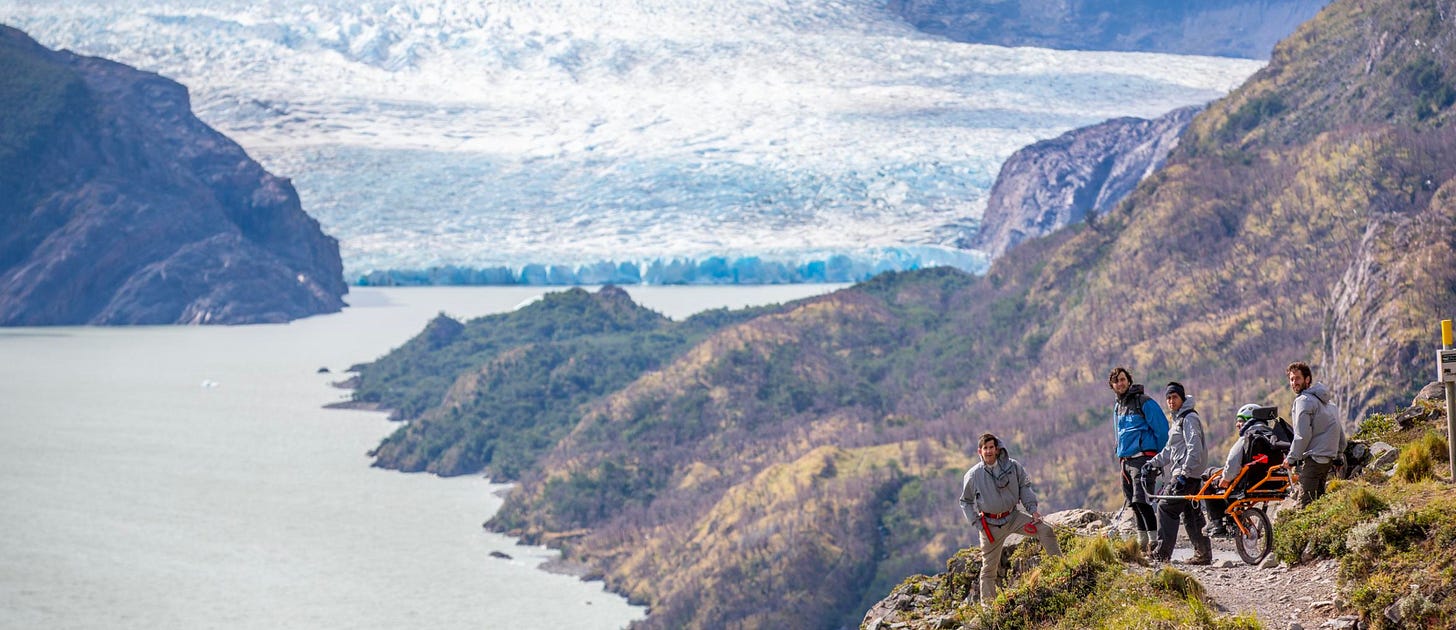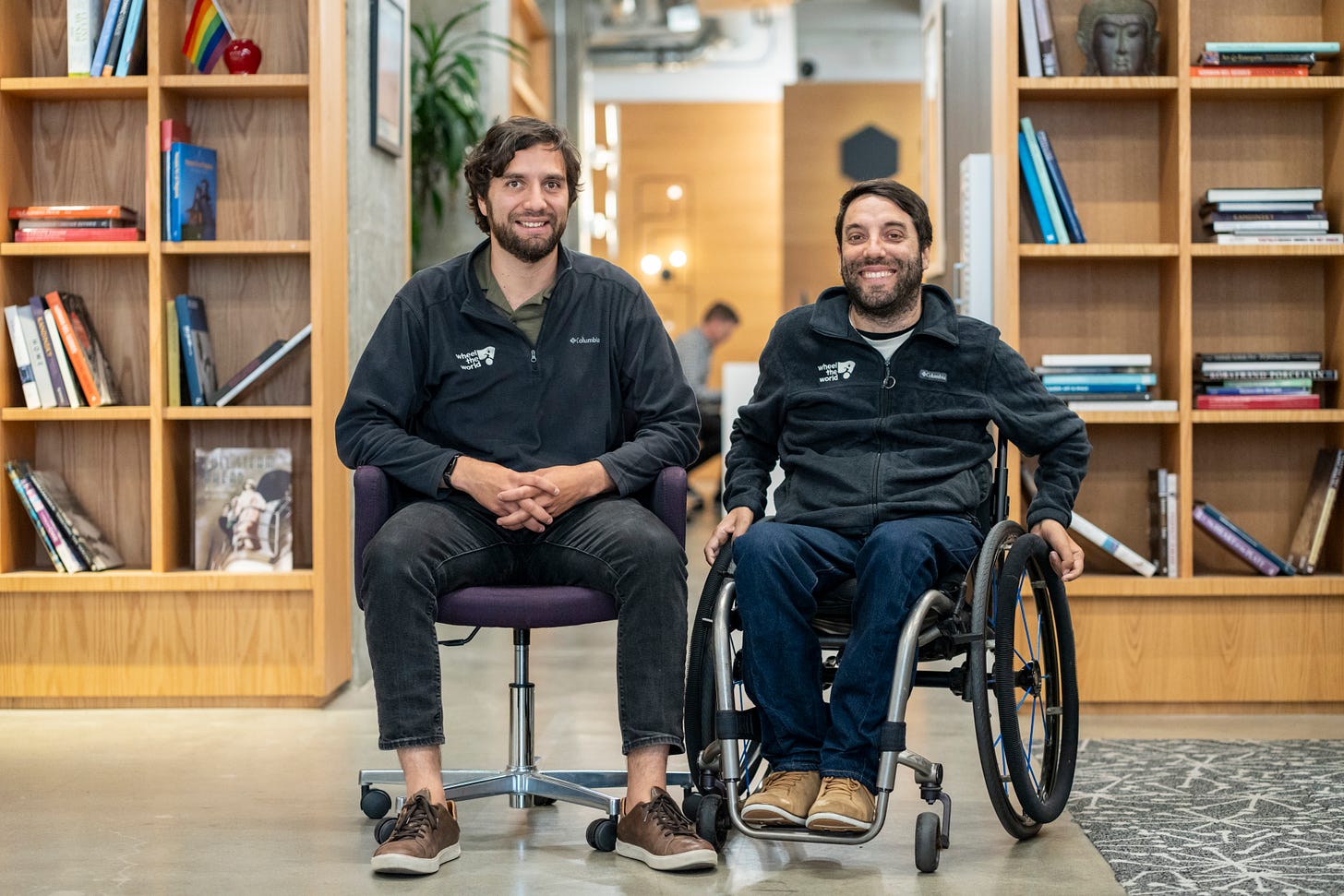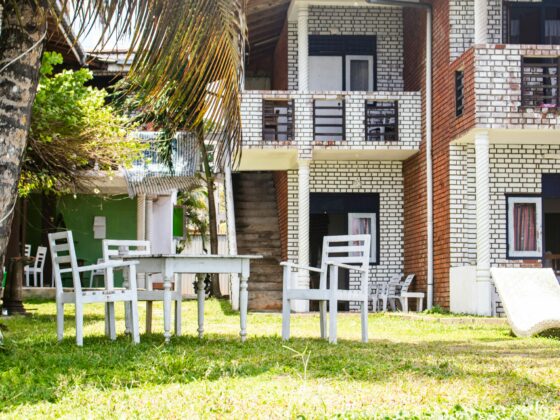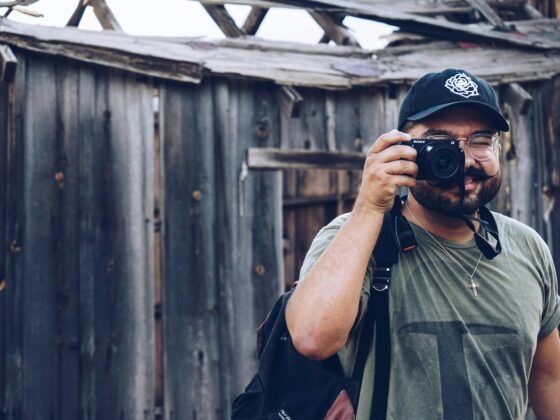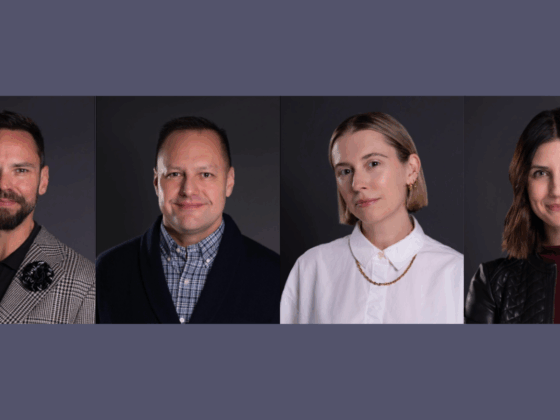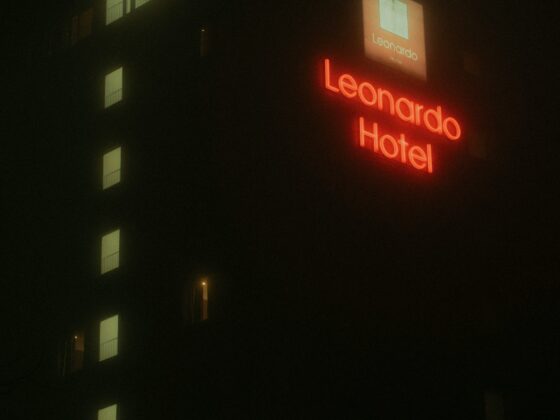Building the accessibility data layer for the travel industry
Welcome to the 5th sponsored deep dive on Travel Tech Essentialist. I publish six of these per year, each one zooming in on a standout company that’s shaping the future of travel. They’re free for all subscribers and meant to go deeper than the usual headlines, with practical insight into strategy, execution, and what’s actually working. If you’re curious how I pick these companies, here’s the thinking behind it.
Today, we’re exploring Wheel the World, a company building the infrastructure to make travel accessible for everyone. I’ve been following founders Alvaro Silberstein and Camilo Navarro since 2019, watching them methodically transform both the experience of travelers with disabilities and the entire industry’s approach to accessibility.
Wheel the World is building the accessibility data layer for a global accessible travel market valued at more than $120 billion and growing. What began as a travel booking platform for people with disabilities has evolved into a B2B2C flywheel: a proprietary verification and mapping technology powers Accessibility Verified. Adopted by 4,000 hospitality businesses in 80+ destinations to evaluate, improve, and promote their accessibility, and fuels bookings through Wheeltheworld.com, the largest global community of travelers with accessibility needs. With over $3.5 million in annualized revenue today and a projected $6 million for 2025, Wheel the World is experiencing 2x year-over-year growth and achieving 70% gross margins. The company is now raising a Series A to scale its adoption and become the gold standard for accessibility across the hospitality industry.
Let’s dive in.
The impossible trek
In 2017, Alvaro Silberstein faced the rugged trails of Torres del Paine National Park in Patagonia. Unlike the other hikers around him, Alvaro couldn’t feel the ground beneath his feet. In his specialized wheelchair, he had become the first person with quadriplegia to complete the legendary W Trek.
As he looked out over the landscape, a realization struck him: the greatest barrier to accessibility wasn’t the mountain before him, but the information that would have told him he could climb it.
For Alvaro, this journey began long before Patagonia. In 2004, as a freshman studying Computer Science in Santiago, Chile, a car accident left him with a C5 spinal cord injury. Suddenly, the world became a much harder place to navigate, with full paralysis from the chest down and complete dependence on a wheelchair for mobility.
Fast forward to 2015, as Alvaro was preparing to move to California for his MBA at UC Berkeley. His friend Camilo Navarro was planning a solo backpacking trip to Torres del Paine in Patagonia. The day before Camilo left, Alvaro asked half-jokingly: “Check if there’s any way I could go someday.”
Without hesitation, Camilo replied: “Hell yeah.”
Two years later, after meticulous planning, fundraising for a special hiking wheelchair, and assembling a dedicated team, Alvaro became the first wheelchair user to complete the iconic W Trek in Patagonia.
The expedition had four goals:
-
Make Alvaro’s dream come true
-
Leave the equipment at the park for others to use
-
Map accessibility information so others could follow
-
Prove that travel and adventure should be for everyone
“That trip changed everything for me. It was the most incredible experience of my life and the spark for what would become Wheel the World.” — Alvaro Silberstein
When their story went viral, reaching Chilean national news, global media outlets, and even getting a shoutout from Mark Zuckerberg during a Q&A at Meta HQ, hundreds of people with disabilities reached out with the same question: “How did you do it? Can I do it too?”
That five-second moment of realization on the mountain evolved from a personal victory into a mission. Alvaro and Camilo recognized they had discovered an information gap that prevented millions from experiencing the world. In 2019, they formally launched Wheel the World, expanding their focus beyond one trek to building something that could open the world as a whole to people who had repeatedly heard the word ‘impossible.
The information gap
For the 1.3 billion people worldwide living with disabilities, travel involves far more than finding the best deals or most Instagram-worthy destinations. It requires addressing fundamental accessibility concerns: Are doorways wide enough for a wheelchair? How high is the bed? Is there a roll-in shower or merely a bathtub? Will staff know how to assist someone with autism? Is there auditory guidance?
The current state of accessible travel information is trapped in a paradox where regulation and reality diverge sharply. Hotels meticulously document pillow firmness, thread counts, and minibar selections, yet fail to communicate whether someone using a wheelchair can actually enter the bathroom.
Every hotel obsesses over thread count but can’t tell you if someone in a wheelchair can reach the bathroom sink. We’re not fixing hotels, we’re fixing information — Camilo Navarro
The numbers that matter
At first glance, one might dismiss accessible travel as a niche market. But pull back the curtain, and you’ll discover a massive, chronically underserved segment hiding in plain sight:
-
15% of the global population, 1.3 billion people, live with a disability, and an additional 1.3 billion companions assist or live with them. This is 30% of the world population
-
They collectively spend $120 billion annually on travel
-
Yet 97% of travel content lacks meaningful accessibility information
-
Only 3% of destinations adequately serve this market today
-
8 out of 10 travelers with disabilities face accessibility issues while traveling, primarily due to false or misleading expectations about accessibility.
Put another way: 3 billion people are affected by accessibility needs, controlling $120 billion in annual travel spending, yet the industry largely ignores them. It’s the equivalent of every airline deciding not to serve business class travelers.
With the global population aging, the market is expanding. We’re all headed toward having accessibility needs. We’re looking at the future of travel demand. Wheel the World’s data shows that 35% of users on their platform are 65 or older, reinforcing that accessibility is a preview of everyone’s future.
Without solving this information gap, millions will continue to lose their freedom to explore, businesses will leave billions on the table, and as our population ages, the severity of this crisis will only intensify.
“Accessibility is not a matter of if, but when. As people age, accessibility needs increase and seniors already represent the largest demographic living with disabilities.” Alvaro Silberstein
Where current solutions fail
The current state of accessible travel information is trapped in a paradox where regulation and reality diverge sharply. Hotels meticulously document pillow firmness, thread counts, and minibar selections, yet fail to communicate whether someone using a wheelchair can actually enter the bathroom.
Take the United States, widely considered the gold standard for accessibility due to the Americans with Disabilities Act (ADA). The law has successfully created structural access (ramps, elevators, wider doorways) but it has a crucial blind spot: it mandates infrastructure, not information.
This gap leads to a surprising reality Wheel the World has documented: ADA-compliant doesn’t mean functionally accessible. Their detailed mapping has revealed that many supposedly “accessible” hotel rooms have beds that are too high for most wheelchair users to transfer into independently. To put it in perspective, trying to transfer into one of these beds is like asking an able-bodied person to climb into a bed that’s two meters high.
Meanwhile, Europe, a region with many more architectural barriers and older infrastructure, tends to have more functional bed heights, despite the overall environment being less accessible in other ways.
The problem extends to booking platforms as well. Mainstream OTAs like Booking.com, Expedia, and Airbnb offer what appears to be helpful accessibility filters, but the reality is far more frustrating:
-
These platforms typically display just 1-15 unverified accessibility features
-
Hotels and hosts self-declare these features with zero validation
-
There’s no standardized understanding of what “accessible” actually means
-
In many cases, the declared features directly contradict what’s visible in the listing photos
This creates a dangerous game of accessibility roulette. A traveler might filter for “wheelchair accessible” accommodations, book what seems perfect on paper, arrive after a long journey, and discover they can’t even enter the bathroom.
Consider this real-world experiment: Try searching Airbnb for properties with a “roll-in shower,” one of the most requested features by wheelchair users. In most destinations, while the filter exists, the results come back empty. They’ve created the checkbox but don’t have the inventory to back it up.
“As a T10 Para traveling has been difficult, there are multiple times I have showed up to a hotel to find that the accessible room I reserved was not available, basically ruining a vacation not being able to shower/bathroom etc. (…)Wheel the World has been amazing to finding the exact accommodations I need. I’ve never had to worry about having a proper accessible room since using Wheel the World.” — Forest Smith, Wheel the World customer
The result is that people with disabilities either don’t travel at all or face anxiety-inducing uncertainty with every booking. When accessibility information is unreliable, travelers with disabilities face impossible choices: take a risk on potentially unsuitable accommodations, limit themselves to chain hotels with standardized (but often sterile) accessible rooms, or simply not travel at all.
It represents a massive failure of information, not necessarily intent, and that’s exactly where Wheel the World sees the opportunity.
The “Aha” moment: Accessibility isn’t a compliance problem; it’s an information problem.
Building the accessibility layer
Wheel the World has evolved significantly from its origins organizing accessible trips to Patagonia. Today, it’s building what CEO Alvaro Silberstein calls “the accessibility data layer for the travel industry”, a comprehensive platform that serves both travelers with disabilities and the businesses that want to accommodate them.
This transformation wasn’t just about scaling a business. It was about recognizing the deeper opportunity to flip the entire paradigm from “accessibility as burden” to “accessibility as opportunity.”
The company now operates two complementary business lines that create a powerful flywheel:
1. Accessibility Verified (B2B)
An accessibility management system used by destinations and hospitality businesses to:
-
Audit, improve, and showcase their accessibility
-
Receive detailed mapping, insights, and improvement plans
-
Access Wheel the World Academy for staff training
-
Integrate accessibility data via API for their own channels
2. Wheeltheworld.com (B2C)
A specialized travel booking platform offering:
-
Verified accessibility details (200+ data points per listing)
-
Personalized travel matching via user accessibility profiles
-
Community and trust through reviews and mission-driven focus
The accessibility flywheel
Wheel the World’s genius lies not just in solving the accessibility problem, but in creating a self-reinforcing system where success breeds more success:
-
B2B verification creates inventory
Destinations sign up for Accessibility Verified, getting their properties mapped with 200+ data points. Each verified location becomes discoverable inventory.
-
Inventory attracts travelers
As wheeltheworld.com gains more verified accessible accommodations, travelers with disabilities finally have options they can trust. The platform becomes their go-to resource.
-
Traveler demand drives more B2B adoption
Hotels and destinations see real bookings from the Wheel the World community. What started as a “nice to have” accessibility initiative becomes a measurable revenue driver.
-
Data improves, trust builds, cycle accelerates
More properties mapped means better recommendations. More bookings create social proof. Trust compounds, attracting more travelers and destinations wanting to capture this demand.
The flywheel is already spinning: the company is projecting $6 million in annualized revenue for 2025, with 85% of that coming from B2B, demonstrating that the industry views accessibility as essential infrastructure, not an optional charity.
“We’re not just helping people navigate the world. We’re helping the world become more navigable.” — Alvaro Silberstein
The secret sauce: structured accessibility data at scale
At the core of Wheel the World’s competitive advantage is its approach to accessibility data collection, transforming what’s typically subjective and inconsistent into a standardized, repeatable process.
The company has codified accessibility into a taxonomy of over 200 data points, considering all types of disabilities. These points cover everything from entrance width to bed height, silent rooms, ramp slope, restroom layout, sensory kit, and lighting conditions. This structured framework is operationalized through their Accessibility Mapping System (AMS), a mobile app used by trained mappers to collect detailed information on-site.
Much like Instacart has shoppers, Wheel the World has mappers, locals they recruit and train to gather data consistently and objectively. This creates a flexible, scalable mapping network that can be deployed anywhere in the world.
Where mainstream platforms offer checkboxes, Wheel the World delivers verification. Each accessibility feature is linked directly to photos that illustrate that specific element, whether it’s a roll-in shower, bed clearance, or door width. Nothing is left to interpretation or misrepresentation.
Even more importantly, they’ve built personalization into the system. Travelers create an Accessibility Profile detailing their specific needs, and the platform recommends only properties that match those exact requirements. This eliminates the guesswork and uncertainty that plague accessible travel planning.
The next generation represents a quantum leap in accessibility mapping. Their upcoming system combines three breakthrough technologies:
-
LiDAR scanning uses smartphone sensors to create precise 3D maps of spaces, automatically measuring door widths, ramp angles, and clearance heights. What once required a trained mapper with measuring tape now happens in minutes with a phone.
-
AI-powered analysis processes these 3D scans to identify accessibility features and flag potential barriers. The AI has been trained on thousands of verified accessible spaces, learning to spot the difference between truly accessible bathrooms and those that merely look compliant.
-
Crowdsourced validation enables the community to verify and update information. A wheelchair user who visits a hotel can quickly confirm that the roll-in shower actually works as described, keeping the database current.
Together, these innovations reduce mapping costs by up to 70% while increasing accuracy and speed. More importantly, they create a sustainable path to mapping millions of properties globally, the scale needed to make accessibility information as ubiquitous as WiFi details.
This technology stack becomes Wheel the World’s ultimate competitive moat. While competitors might copy their business model, replicating years of accessibility data training and community validation would take decades. This emphasis on data quality and verification creates trust, the essential ingredient that’s missing from mainstream travel platforms’ accessibility features.
This emphasis on data quality and verification creates trust, the essential ingredient that’s missing from mainstream travel platforms’ accessibility features.
The proof is in the bookings
Wheel the World’s approach is resonating powerfully with both travelers and the travel industry. Their growth tells a compelling story of market validation:
Their B2C platform, wheeltheworld.com, has shown remarkable momentum, with bookings more than quadrupling from 900 in 2022 to 4000 in 2024, representing consistent 2X+ annual growth. These bookings generated $3.3 million in gross booking value in 2024 alone, translating to $453K in direct B2C revenue.
But the numbers tell a deeper story than just growth:
-
35% repeat customer rate shows this isn’t just novelty. It’s solving a real problem
-
70% Net Promoter Score demonstrates exceptional satisfaction
-
60% of new users come through organic channels rather than paid acquisition
-
3x lifetime value to customer acquisition cost ratio over three years
Even more telling is how their business model has evolved. What began as a pure B2C play has transformed, with their Accessibility Verified B2B service now accounting for 84% of total revenue. This dramatic shift reflects that destinations and hospitality providers are shifting their perception of accessibility from a compliance requirement to a business opportunity.
Wheel the World’s verification business now spans 80 active destinations covering 4,000+ partners (hotels, attractions, restaurants) and delivers healthy 70% gross margins.
What’s particularly impressive about Wheel the World’s traction is that they’ve achieved it while staying capital efficient. Rather than burning cash to drive growth at all costs, they’ve built methodically toward a sustainable model that delivers genuine value on both sides of their marketplace.
The 150,000 voices changing travel forever
Wheel the World is going beyond building a booking platform. They’re cultivating a movement. Their growing community of 150,000 travelers with accessibility needs forms a powerful collective that’s actively reshaping the travel industry from the ground up.
These members serve as passionate advocates who share their victories and frustrations, swap accessibility tips for destinations worldwide, and celebrate newfound freedoms together. When someone who hasn’t traveled in years finally books that dream trip to Machu Picchu or the beaches of Thailand, the entire community celebrates.
“Had the most amazing experience with Wheel the World traveling to Peru to see Machu Picchu!! Our journey began when the guide met us at the Cusco airport… The van was big and very accessible. We spent two days exploring Cusco and two days in Machu Picchu. I can’t wait to travel with them again!” — Amy Currotto, Wheel The World customer
This connection runs deeper than typical brand loyalty. It transforms into genuine word-of-mouth magic that traditional marketing could never replicate. An impressive 60% of Wheel the World’s new travelers come through organic referrals; friends telling friends, “You’ve got to try this. It actually works for people like us.”
The community also serves as the company’s most valuable feedback loop:
-
When a hotel claims to be accessible but the bathroom door proves too narrow, community members flag it immediately
-
When a tour operator goes above and beyond to accommodate a wheelchair user, that recommendation spreads like wildfire
-
Community members working in the travel industry become internal champions, influencing accessibility policies from the inside
As the community grows, so does its influence. Hotels and destinations are beginning to recognize that accessibility represents both ethical practice and smart business, a pathway to a passionate market of travelers eager to explore. The collective voice of 150,000 advocates carries weight that a single company alone never could, driving better standards industry-wide.
This illustrates how meaningful change happens: through the united voice of a community that refuses to remain on the sidelines any longer.
Zach Carlsen’s experience illustrates the transformative power of this approach: “I would give 10 stars if I could, honestly. I did a lot of research before booking our tour and Wheel the World lived up to every word in their marketing and presentation. We spent over a week touring Greece and the team literally thought of everything.”
The human element
What makes Wheel the World compelling goes beyond its business model or technology. The authenticity of its mission is what stands at the core.
Around 40% of the Wheel The World team either lives with a disability or is directly connected to someone who does. They’re not building for an abstract market; they’re building for themselves, their families, and their communities.
For Alvaro, leading Wheel the World intertwines business metrics with deeply personal experience. As both CEO and a wheelchair user, he brings a unique perspective to product decisions and strategic direction. When discussing hotel mapping priorities, he considers market potential alongside the actual experience of navigating spaces with a disability.
I test our product every day as both CEO and user. When we debate features or partnerships, I constantly ask, ‘Would this actually work for me? Would I trust this enough to book my own travel through it?’ — Alvaro Silberstein
This lived experience creates an authenticity that resonates with both customers and industry partners. Hotels and destinations aren’t just talking to a tech company. They’re learning from someone who has personally faced the challenges their accessibility improvements will address.
This connection to the problem creates a depth of understanding that would be difficult to replicate. It drives how they prioritize features, test solutions, and measure success.
The remaining 60% of the team may not have direct lived experience, but they’re deeply aligned with the mission, people who understand that accessibility is fundamentally a design challenge and an opportunity for impact.
Unlocking a $120 billion market
The opportunity facing Wheel the World extends beyond improving travel for people with disabilities; it unlocks an entirely new revenue stream for the travel industry.
For destinations and hospitality businesses, accessibility is transforming from a compliance cost to a competitive advantage. With the proper infrastructure and information, they can tap into a $120 billion annual travel expenditure that’s largely been left on the table.
The company’s vision extends far beyond travel, positioning Wheel the World to become the global standard for accessibility data across multiple industries:
-
Hotels (current focus)
-
Cruises (next expansion)
-
Convention centers
-
Restaurants
-
Museums and visitor centers
-
Airports
-
Stadiums
-
Vacation rentals
-
Housing
As Camilo puts it, they’re building beyond today’s travel challenges, creating “the infrastructure for a world where accessibility becomes expected, while trust and accuracy remain essential.”
The road ahead
Despite its impressive traction, Wheel the World faces challenges as it scales:
-
Awareness and education: Many destinations and hotels don’t recognize the revenue opportunity in accessibility or believe it’s too expensive/complex to tackle.
-
Mapping economics: While their current mapping system works, the cost needs to come down to achieve true global scale, a challenge they’re addressing with LiDAR and AI.
-
Competition from giants: Google, Booking.com, and Airbnb all have accessibility filters, though they’re unverified and limited in scope. As accessibility becomes more mainstream, these platforms could improve their offerings.
But the biggest opportunity lies in reimagining how we conceptualize accessibility altogether; shifting from a compliance mindset to a design opportunity, from a niche consideration to a universal benefit.
“By 2050, it’s projected that over 2 billion people worldwide will live with a disability. Travel will no longer be a luxury for a select few with accessibility needs; it will be an expectation.” — Alvaro Silberstein
When Alvaro first sat in his specialized wheelchair at the entrance to Torres del Paine, everyone told him the journey ahead was impossible. Today, as Wheel the World maps thousands of locations and serves its growing community of travelers, the company proves that accessibility can be both possible and profitable.
What’s next: building the accessibility infrastructure of tomorrow
Wheel the World stands at an inflection point. They’ve proven the model works, built a defensible data moat, and demonstrated real traction on both sides of their marketplace. Now comes the next chapter: scaling from a successful startup to the global standard for accessibility.
The company is raising a Series A round to accelerate the development of accessibility mapping technology using LiDAR and AI, expand its B2B sales, and scale its B2B business. It targets 20,000 verified sites and over $20 million in revenues by 2027. This ambitious goal would transform accessibility data from scarce to ubiquitous across the travel industry.
Wheel the World has already raised $10 million across a Seed and Pre-Series A rounds, with support from highly aligned investors who deeply believe in their mission. Notable backers include Detroit Venture Partners, whose sole limited partner is Dan Gilbert, a billionaire with a disability who uses a wheelchair. Dan decided to invest after personally using WheeltheWorld.com to book a family trip.
The company is also backed and advised by Gillian Tans, former CEO of Booking.com, who brings unmatched expertise and industry credibility.
The vision extends beyond travel bookings. Wheel the World aims to establish itself as “the Stripe of accessibility,” an invisible yet indispensable infrastructure that powers how accessibility is delivered, maintained, and personalized at scale.
Just as Stripe became the hidden payment layer that powers millions of transactions without users ever thinking about it, Wheel the World wants to become the accessibility layer that ensures every travel experience is truly inclusive.
Wheel the World is transforming the travel industry. Their vision for inclusive travel is unmatched. The huge players in the market are always seeking new market segments and becoming inclusive for all, but they will never be as good as Wheel the World in solving the accessibility problem. — Gillian Tans, Former CEO, Booking.com
Conclusion
By building the accessibility data layer for the travel industry, Wheel The World transforms “impossible” into “I’m possible” for millions of travelers, one verified data point at a time.
We often think of travel as freedom. The ability to explore, discover, and experience the world on our own terms. For millions of people with disabilities, that freedom has been unnecessarily limited, not by their conditions, but by a systemic failure of information.
Wheel the World is building a better travel booking platform and creating the infrastructure for a more inclusive world where detailed, verified accessibility data becomes as fundamental to our physical spaces as GPS coordinates are to digital maps.
By addressing these accessibility challenges, they’re unlocking a substantial market opportunity while fulfilling something far more significant: liberating the human potential of travelers long relegated to the sidelines.
As we look to the future of travel tech, companies like Wheel the World remind us that the most transformative innovations aren’t always about making things faster or cheaper. Sometimes, they’re about making the impossible possible.
This is the 5th sponsored deep dive on Travel Tech Essentialist. I write these pieces to highlight innovative companies shaping the future of travel, with full editorial independence. To ensure quality and exclusivity, I limit these deep dives to just 6 per year. If you’re a travel company interested in being featured in a future sponsored deep dive, please visit my deep dive philosophy page to understand my selection criteria and reach out through the contact link there.
